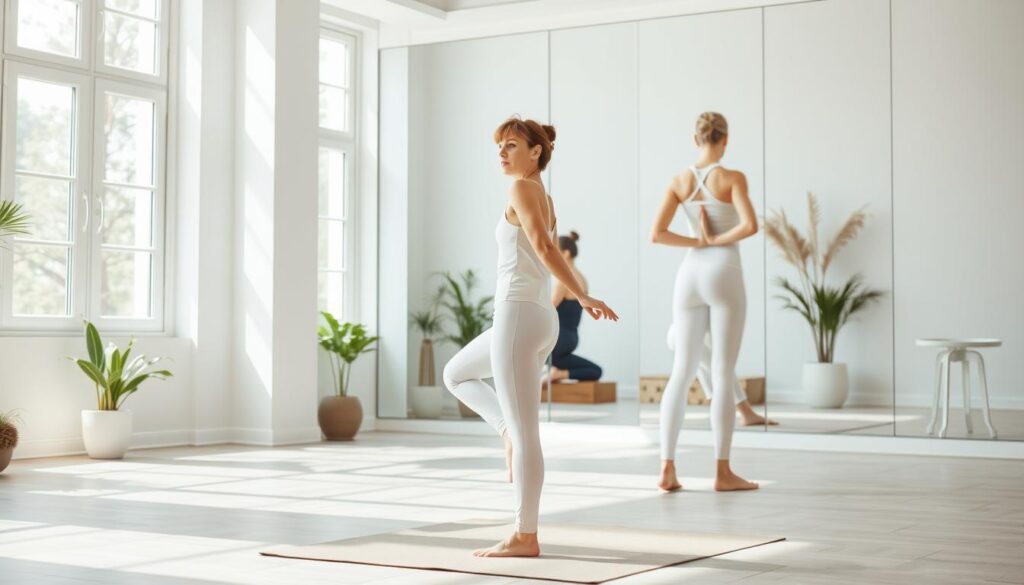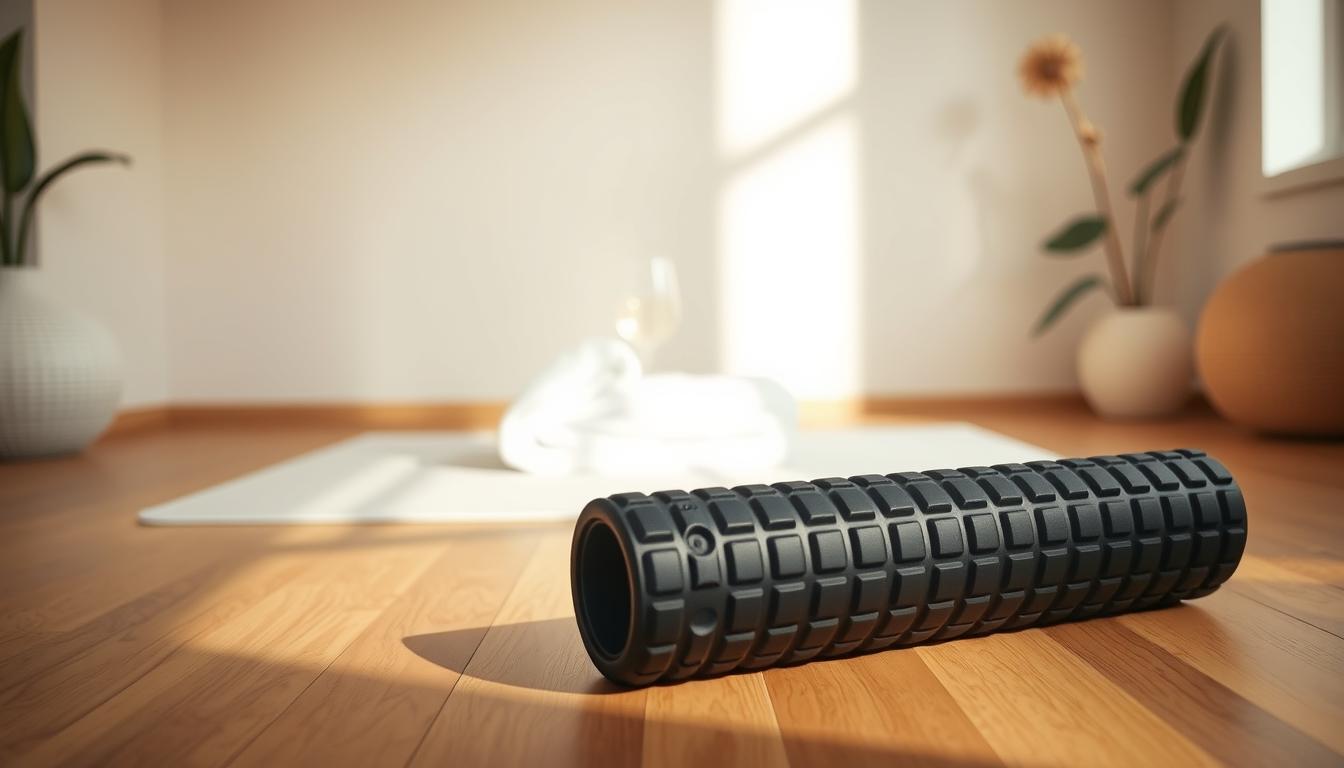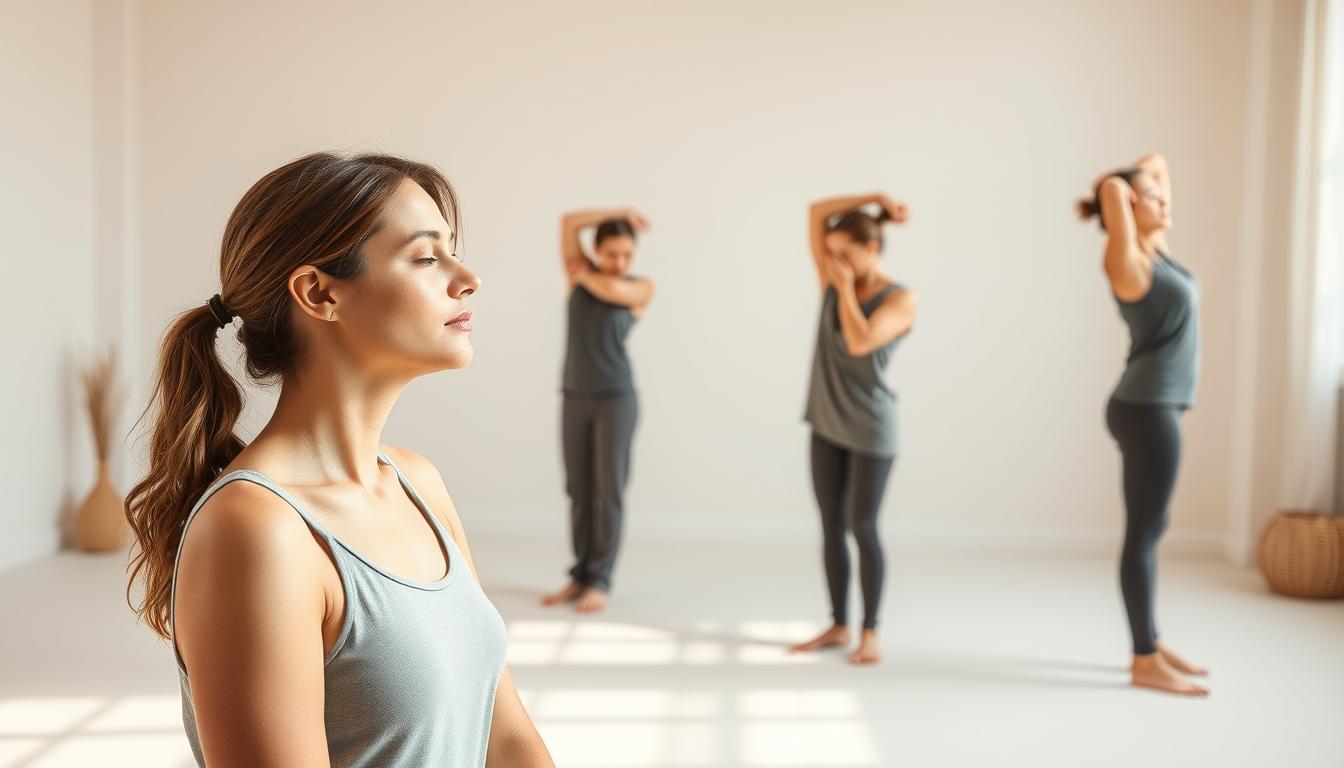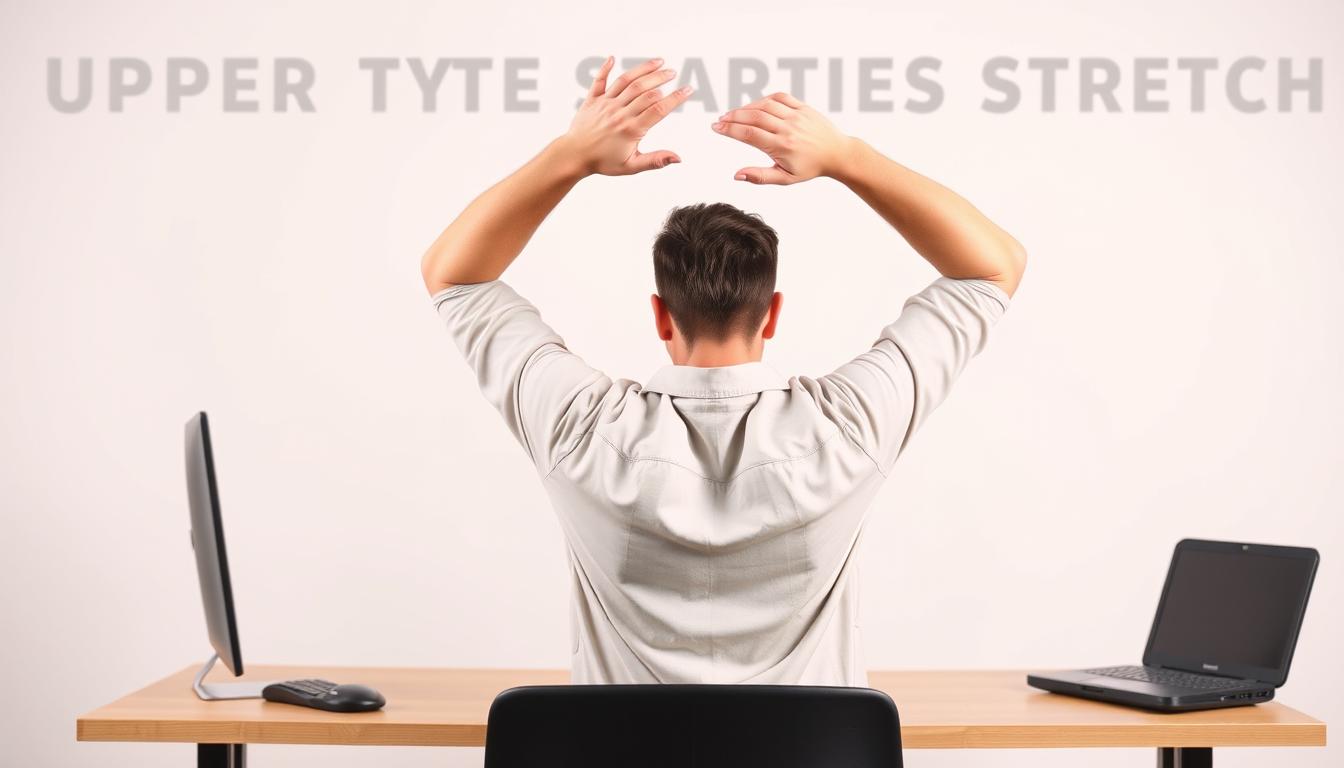In today’s fast-paced world, many people have poor posture. This often includes a forward head posture, leading to ongoing neck pain. This article shares key exercises that can better your posture and ease neck discomfort. By practicing these simple exercises, you can fight off the bad effects of poor alignment. Adding these exercises to your daily life can help you improve your posture and lower muscle pain.
Understanding Forward Head Posture
Forward head posture, known as “Scholar’s Neck” or “Text Neck,” happens when your head leans too far forward. This problem is now seen in about 66% to 90% of people. It’s important to know what it is, its symptoms, and why it happens to deal with it.
What is Forward Head Posture?
This issue means your head and neck aren’t aligned right, making your head stick out. This looks like your head is in front of your shoulders. Over time, this can lead to different problems and discomfort.
Common Symptoms of Forward Head Posture
Knowing the signs of forward head posture helps catch it early. The main symptoms include:
- Neck pain and stiffness
- Tension headaches
- Shoulder stiffness
- Poor balance
- Fatigue
Spotting these signs early matters to avoid more issues with neck and upper back health.
Causes of Forward Head Posture
Many things lead to forward head posture. Its top causes are:
- Prolonged smartphone and computer use
- Poor ergonomics in the workplace
- Weak neck and upper back muscles
Knowing these causes can help people make changes to lessen this posture’s impact.
The Impact of Poor Posture on Health
Poor posture leads to serious health issues. It starts musculoskeletal problems, causing symptoms. Over time, it means chronic neck and shoulder pain. This affects how we live and move. Recognizing these effects helps us work on better posture.
Musculoskeletal Issues
Poor posture majorly harms our musculoskeletal health. It throws off our body’s balance. This puts stress on our muscles and joints. Key problems include:
- Increased risk of herniated discs
- Muscle spasms due to overexertion
- Development of thoracic kyphosis
These issues lead to ongoing neck and shoulder pain. They affect our movement and life quality.
Effect on Neck and Shoulder Health
The way we slouch pushes our head forward. This puts extra stress on our neck. Studies show this can hurt cervical muscles and joints. We might feel from slight discomfort to severe pain. This limits our daily activities, trapping us in a cycle of pain.
Importance of Correcting Posture
Correcting posture is very important in everyday life. When people make sure they stand and sit straight, they gain health benefits. This includes looking better and feeling more energetic.
Benefits of Good Posture
Standing or sitting straight brings many perks that improve your life. These benefits are:
- Less pain in back, neck, and shoulders.
- Better balance and stability, key for being active.
- Doing better in sports and everyday tasks.
- Improved breathing, leading to more oxygen in your body.
- Easier digestion by keeping organs lined up right.
- More confidence, making socializing easier.
How Posture Affects Overall Well-being
Having good posture is vital for your physical and mental health. It helps avoid long-term issues like arthritis and slipped disks. It also keeps you feeling lively. Good posture means more energy, while poor posture can make you tired and unmotivated. Paying attention to how you sit and stand is key to feeling good every day.
Simple Exercises to Improve Posture and Reduce Neck Pain
Adding specific exercises to your daily life can really help your posture and ease neck pain. These activities work by making muscles stronger, making you more flexible, and improving how you stand or sit. Let’s look at three great exercises for better posture.
Chin Tucks Exercise
The Chin Tucks Exercise is all about strengthening the muscles deep in your neck. This helps keep your head aligned right. Here’s how to do it:
- Start by sitting or standing up straight.
- Then, gently bring your chin down towards your chest, but don’t bend your head forward.
- Stay like this for 5 seconds, feeling the stretch at the back of your neck.
- Do this 10-15 times during the day.
Neck Flexion (Suboccipital Stretch)
The Neck Flexion, or the suboccipital stretch, is for the tight muscles at your skull’s base. It eases neck pain and tension. Here’s how to stretch properly:
- Take a seat with your back up straight.
- Lower your chin to your chest to stretch your neck.
- Hold the stretch for 15-30 seconds and breathe deeply.
- Repeat it 2-3 times for the best results.
Thoracic Spine Foam Rolling
Rolling the thoracic spine can reduce upper back tension and promote more mobility. You’ll need a foam roller for this exercise:
- Lie down with a foam roller under your upper back.
- Keep your head in your hands and gently roll back and forth.
- Pay extra attention to any tight spots, spending more time there.
- Include this in your daily routine for 1-2 minutes.
Stretching Exercises for Neck Pain Relief
Adding good neck stretches to your daily routine can really help ease neck pain. The Upper Trapezius Stretch and the Child’s Pose work great for easing muscle tension and enhancing posture. Doing them often improves flexibility and helps keep your spine healthy.
Upper Trapezius Stretch
The Upper Trapezius Stretch helps loosen up tight muscles in your neck and shoulders. You can do it sitting or standing. Just tilt your head to one side and use the opposite hand to pull your head gently toward the shoulder. Keep this up for 15 to 30 seconds to stretch the side of your neck. Then switch sides. It’s great for easing neck soreness.
Child’s Pose to Lengthen the Spine
The Child’s Pose is a soft stretch for your spine, glutes, and lower back and helps with neck tension too. Start on all fours, then sit back on your heels and stretch your arms out in front. Let your forehead touch the ground. Hold it for a minute or more, breathing deeply. It’s relaxing and great for neck pain relief.
Strengthening Exercises to Support Good Posture
Adding posture strengthening exercises to your daily plan can greatly improve core strength and body alignment. These exercises focus on important muscles that help hold up your posture, making day-to-day tasks easier. Plank variations and glute bridges are two helpful exercises for these purposes.
Plank Variations for Core Stability
Planks are excellent for building a stable core, which keeps your posture upright. By engaging your core, you help keep your spine stable, lowering injury chances. Here’s how to do a plank:
- Start in a push-up position with your elbows directly beneath your shoulders.
- Engage your core, keeping your body in a straight line from head to heels.
- Hold this position for 30 seconds to 1 minute, breathing steadily.
- For a challenge, try side planks or plank variations that include moving arms or legs.
Glute Bridges for Hip Alignment
Glute bridges tackle the bad effects of sitting too much by working on hip alignment. They get your glute muscles working, which helps with your posture and eases lower back pain. To do a glute bridge, follow these steps:
- Lie on your back with your knees bent and feet flat on the floor, hip-width apart.
- Press through your heels, lifting your hips toward the ceiling while squeezing your glutes.
- Hold the top position for a few seconds before lowering back down.
- Repeat for 10 to 15 repetitions, concentrating on controlled movements.
Daily Habits to Enhance Posture
Creating daily habits to improve your posture boosts your health and comfort. Ergonomics at work is crucial for good posture. It makes a supportive space that reduces body strain. Small changes in your workspace can greatly help your back’s health.
Importance of Ergonomics in the Workplace
Adjust your work area using ergonomic ideas for better posture. Here’s what to do:
- Ensure your computer monitor is at eye level to reduce neck strain.
- Use an adjustable chair that supports the natural curve of your spine.
- Position keyboard and mouse within easy reach to promote relaxed shoulders.
- Take regular breaks to stand, stretch, and reset your posture.
Maintaining Awareness of Posture
Being aware of your posture all day helps build healthy habits and stop bad slouching. By paying attention, you can:
- Check your alignment while sitting, standing, and walking.
- Practice small posture exercises during breaks.
- Use reminders, like sticky notes or phone alerts, to keep thinking about your posture.
These methods will help you see lasting benefits in your posture and overall health.
Yoga Poses for Enhanced Posture
Adding yoga to your daily life can make your posture better. Poses like cat-cow and downward-facing dog focus on making your spine straight and flexible. Doing these yoga stretches often can ease tension and build a stronger posture.
Cat-Cow for Spinal Flexibility
Cat-cow pose is great for making your spine more flexible. Moving between these two shapes makes your spine move, leading to more stretch and less pain. This pose makes you more aware of your body’s position, helping improve your posture.
Downward-Facing Dog for Back Alignment
Downward-facing dog is a key pose for a stronger, aligned back. It fights the bad effects of slouching by stretching your spine. Adding this pose to your practice brings better back alignment and increases your feeling of balance and health.

Consultation with Professionals
Getting help from a pro for posture problems is key, especially if trying it alone doesn’t work. A physical therapist has the skills to diagnose and fix issues with muscles and bones. They give valuable advice and direction for improving posture.
When to Seek Help from a Physical Therapist
It’s essential to see a physical therapist if neck pain messes with your daily life. Or if bad posture is causing you pain. Here are some signs you need expert help:
- Persistent pain that doesn’t get better with self-care.
- Not being able to move your neck or shoulders freely.
- Feeling more pain when doing certain things.
Importance of Personalized Exercise Plans
Physical therapy for neck pain focuses on exercises made just for you. Having a plan made for your needs helps you heal better. A professional will look at how you stand and make a plan to:
- Fix the posture problems that are unique to you.
- Keep an eye on how you’re doing and change the plan if needed.
- Make sure you stay on track safely without getting hurt.
Integrating Exercises into Your Routine
Fighting neck pain and getting better posture is key. Making it a part of your everyday life is crucial. Doing this through a set routine can help. It builds good daily habits for easing neck pain.
By picking specific times for these exercises, you can really help your well-being and posture. This approach has a big impact.
Creating a Daily Stretching Habit
Starting to stretch every day might seem hard. But starting small can lead to big changes. Here are ways to make stretching a daily habit:
- Set reminders on your phone for stretching breaks throughout the day.
- Stretch while doing daily tasks, like during work breaks or in the morning.
- Get friends or join a group for support in keeping up the practice.
Setting Realistic Goals for Improvement
It’s important to set achievable goals for better posture. This keeps you motivated and helps track progress. Begin with goals you can reach, such as:
- Stretch for at least five minutes daily, slowly doing more over time.
- Learn exercises that help your neck and posture the most.
- Watch for better comfort and posture to stick with it.
The Role of Mindfulness in Postural Correction
Mindfulness and posture are deeply connected, affecting our body’s alignment and health. Mindfulness helps increase awareness of poor posture habits. By staying present and mindful of our body, we can notice and fix our alignment.
Mindfulness exercises help us reflect on ourselves and notice body tension. Realizing this tension is key to improving posture. Mindfulness does more than just improve posture—it also helps reduce pain and prevent long-term discomfort.
Adding mindfulness techniques to our daily life boosts body awareness. This makes us more aware of our posture, leading to healthier changes. We start adjusting our posture for the better, which enhances our overall well-being.
Conclusion
Improving your posture and easing neck pain is definitely possible with regular effort and the correct methods. This detailed article has shared great exercises and tips for better posture and reducing neck discomfort. It talks about important exercises like chin tucks and stretches that help a lot.
Starting a daily habit of being mindful about how you move and making your work area ergonomic can really make a difference. Focusing on these strategies matters because good posture isn’t just about health. It also makes you feel more confident and helps you do better in your daily tasks.
To wrap up on bettering posture, it’s clear that mindful habits and expert advice can lead to true improvement. By following these exercises and being proactive about neck care, you can change your posture for the better. This will greatly improve how you feel every day.



